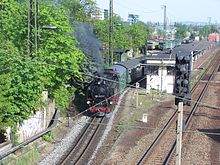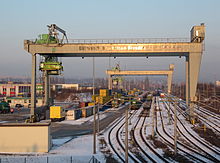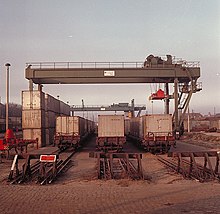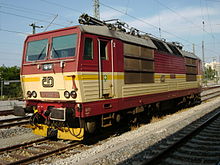Dresden railway junction
The Dresden railway node is a node in the railway network in eastern Germany in Dresden and its metropolitan area . In freight transport, it obliges transports from different directions within Germany to the only electrified transition from Germany to the Czech Republic . In long-distance passenger transport, it is important as the end point of the middle ICE line in east-west direction at a station of the highest category with importance for East Saxony. The node is the northern exit of the Pan-European Transport Corridor IV .
The railway junction has been expanded in recent years. The complex expansion of the node has not yet been completed in some areas or is still being planned.
history
With the opening of the second long-distance route from Dresden to Görlitz in 1847, Dresden became one of the first railway hubs in Germany. The two train stations set up for this purpose were at least within sight of each other, so changing trains was still easy.

With the connection to the Austrian railway network to Prague and Vienna, the need arose for the first time to cross the Elbe at the railway junction. All routes had separate railway systems, which were later connected via the Marienbrücke , built in 1852 . This bridge did not carry road and rail traffic separately. The oldest train station was the Leipziger Bahnhof in the suburb of the same name immediately north of the Elbe bridge. At the location of the Dresden-Neustadt train station was the Silesian train station for traffic to Görlitz and Breslau. The Bohemian Railway Station was located near the later main railway station . There were other long-distance stations for the long-distance routes to Nuremberg and Berlin: The Albertbahnhof , which opened in 1855, was located north of Dresden-Plauen in the area of the later Dresden-Altstadt freight station and the Berlin train station, which opened in 1875, was in the northern area of the later Dresden-Friedrichstadt freight station . Around the Dresden city center (operational) terminal stations were arranged in a semicircle.
The Albertbahnhof was closed again as early as 1869 and the Bohemian Railway Station was used as a replacement. This was the first functional expansion of what will later be the main station.
In the 1870s, the Royal Saxon State Railways began to take over the lines that had previously been operated by private railway companies. The Dresden railway junction was completely owned by the Kingdom of Saxony from around 1888 and was operated by the Saxon State Railways. The kingdom had already regulated the construction and operation of the railway line to Bohemia itself from the beginning and had contracted it with Austria. Until the foundation of the Deutsche Reichsbahn, trains of the Prussian and Saxon state railways ran in the node .
In 1892, the Saxon railway began to connect the railway lines with a powerful node. Two large stations were planned as replacements for the four separate long-distance stations. The three original stations were converted into freight stations. The efficiency of the Elbe crossing should be increased. In 1898 the main station and in 1901 the Neustadt station were opened. Between 1898 and 1901 the first separate railway bridge was built at the Marienbrücke. Between the two stations, the Dresden Wettiner Strasse station ( Dresden Mitte ) was built as the third indoor station on Könneritzstrasse .

In the final months of World War II , the railroad facilities were targeted seven times by air raids . The three large passenger stations and the freight yard in Friedrichstadt were destroyed. Most of the node was back in operation as early as 1945. Parts of the facilities were dismantled after the war as reparations to the Soviet Union (especially tracks of the suburban railway and steel bridges).
On December 14, 1994, Deutsche Bahn, established in January of that year, commissioned the planning company Bahnbau Deutsche Einheit with the preliminary draft planning of the section of the Leipzig – Dresden railway line at the Dresden node . The documents submitted on November 25, 1994 were confirmed by Deutsche Bahn AG in December 1995.
The railway junction is exposed to a risk of flooding in some places. When the Elbe and its tributaries flooded in 2002, the main station was flooded by the Weißeritz . The route to Chemnitz leaves the node to the southwest through the valley of the Weißeritz and was also destroyed there. In the event of severe flooding, the Marienbrücke must be secured against uplift and can then not be driven on. Dresden-Neustadt station is flood-proof, although it is much closer to the Elbe than the main station.
Location and structure
Traffic geography
The entire railway junction extends along the Elbe valley basin . It is located in the core of the Dresden metropolitan area . The Ore Mountains extend southwest to southeast , the higher elevations of which begin south of Freital. To the northwest, still traversed by the foothills of the Central Saxon hill country , the transition to the North German lowlands follows . In the east and north-east are the foothills of the Sudetes . In Pirna the rift valley merges into the breakthrough valley of the Elbe through the Elbe Sandstone Mountains .
In terms of traffic geography, the node fulfills three tasks:
- Crossing the Elbe
- Bundling of rail traffic on the course of the Elbe
- Development of the surrounding mountains through side valleys
Main lines

The node connects the following long-distance and main lines:
- Berlin – Dresden railway line
- Railway line Dresden – Děčín (to Děčín with continuation to Prague )
- Dresden – Werdau railway line (section of the Saxony-Franconian main line to Chemnitz and Nuremberg )
- Görlitz – Dresden railway line
- Leipzig – Dresden railway line
Branch lines
Branch lines connect decentrally in the edge area of the node:
- the Heidenau – Kurort Altenberg railway in Heidenau
- the Borsdorf – Coswig railway in Coswig
- the Dresden-Klotzsche – Straßgräbchen-Bernsdorf railway line in Dresden-Klotzsche
- the Grossenhain – Cottbus railway in Priestewitz
- the Kamenz – Pirna railway in Arnsdorf
Part of the S-Bahn network are the Dresden Airport S-Bahn and the Pirna – Coswig S-Bahn .
Historic routes

Individual branch lines that connect to the node are used as museum railway lines, are narrow-gauge lines or have been closed:
- the Windbergbahn in Freital am Windberg (island operation)
- the Gottleubatalbahn in Pirna (dismantled)
- the narrow-gauge railway Radebeul Ost – Radeburg in Radebeul (daily operation and traditional trains with special timetable)
- the Weißeritztalbahn from Freital to Kipsdorf
- the Pirna – Großcotta railway line (dismantled)
Railway stations and railway facilities
Central systems in long-distance passenger transport are the two long-distance train stations Dresden Hauptbahnhof and Dresden-Neustadt train station . The Dresden-Friedrichstadt railway station is the central freight station of the node with attached freight center for the combined transport . Other important facilities are the Dresden-Altstadt section of the train station and the storage and treatment facility in Dresden-Reick.
The main train station extends in an east-west direction and has 16 platform tracks. Seven of these are located in the ground-level terminus section, surrounded by the through tracks designed as high tracks: four in the northern hall and three in the southern hall. Another two through tracks are located outside the southern hall. They do not have platforms and are used for freight traffic. It is controlled from the Leipzig operations center via two electronic interlockings.
The Dresden-Neustadt station is a through station with eight platform tracks in a north-south direction. In its northern apron, the main routes to Leipzig (in a curve to the west) and to Görlitz (in an uphill straight to the north) divide. Since 2008, the station has also been routed from the Leipzig operations center. Until then, the station was still operated according to the directional principle via local mechanical signal boxes.
The train handling and maintenance facility of DB Regio is located southwest of the main station in the former Dresden-Altstadt freight station. Regional trains are parked and serviced there. The facility is part of the Südostsachsen transport company of DB Regio Südost . The parking facility in the northern apron of the Dresden-Neustadt train station was dismantled.
The Dresden-Friedrichstadt freight station is used for train handling and is built as a gradient station. It has 34 direction tracks into which freight wagons unrolled on one side and trains were put together in single wagon traffic . On its southern side it has the only container terminal for combined transport in Dresden. In cross-border traffic to the Czech Republic, it is an operating point for changing locomotives (due to the need for multi-system vehicles ).
The two long-distance train stations are connected by the Marienbrücke , over which five tracks run. To the west of the junction is the Niederwartha railway bridge over the Elbe.
concept

The knot is built according to the trunk principle. In its basic features it is identical to the condition in 1902. In the western part of the junction, long-distance freight and passenger traffic is separated into two lines: At Radebeul, freight traffic is routed across the Elbe and south of the Elbe reaches the Dresden-Friedrichstadt freight station from the west. Passenger traffic is mainly conducted north of the Elbe. Long-distance trains run to the two long-distance stations on both sides of the Elbe.
There are two triangular tracks between the main train station and Dresden Mitte train station. These establish the connection to the Dresden-Altstadt station section and the Dresden-Friedrichstadt station. The traffic through the Elbe Valley to the Czech Republic inevitably passes the main station. The line between Dresden-Neustadt and Pirna has four tracks (up to six tracks between Dresden-Neustadt and Dresden Hbf) and is driven at speeds of up to 160 km / h. Two of the four tracks are used for S-Bahn traffic and have platforms. The other two tracks are used by long-distance passenger and freight traffic.

The railway line to Chemnitz branches off at the main station in an arc to the south. It quickly reaches the notched valley of the Weißeritz, where it is fed to a first steep ramp to Freiberg.
The line to Görlitz leaves the Neustadt station to the north and goes around the elevations of the West Lusatian hills and mountains on the western and northern edges .
The node is controlled almost exclusively from the Leipzig operations center via electronic interlockings . Exceptions are the signal boxes in Dresden-Altstadt, the parking and treatment facility in Dresden-Reick and in Coswig. During the last expansion, the Dresden node was designed in such a way that the line principle is applied when assigning the platforms.
expansion
node
The expansion of the node was and is essentially part of the German Unity transport project (VDE No. 9 Dresden – Leipzig railway line, second construction phase). A few projects and facilities are still under construction.
In the past, the operational separation of the long-distance routes to Leipzig and Berlin took place in Radebeul . Currently, the long-distance line up to the Kottewitz junction is run on the Berlin – Dresden route parallel to the Leipzig – Dresden route. Both routes run parallel in curvy sections through the southern hill country of the Großenhainer Pflege . Regional and freight trains run via Coswig .
DB Netz built a new train handling and storage facility for long-distance trains in Reick on the area of the Dresden-Reick station, which was dismantled a few years ago. This is about 5 minutes drive from the main train station and can be reached from all continuous tracks in the north and south halls of the main train station. The tracks of the Dresden-Altstadt section of the train station can only be reached from the south hall and from the head tracks in the station hall.
edge
The expansion of the long-distance routes connected to the nodes has been postponed in the medium term or is still in the preliminary planning phases. Construction projects of the edges in the rail network relevant to the node are:
- Expansion of the Berlin – Dresden line (upgrading for speeds of up to 200 km / h)
- Expansion of the Leipzig – Dresden section, Riesa – Dresden section (upgraded for speeds of up to 200 km / h)
- Expansion of the Nuremberg – Hof – Reichenbach line (electrification of the Saxony-Franconian Magistrale )
In the event of the planned high-speed line from Dresden to Prague, the Dresden node would have additional capacity to and from the Czech Republic.
traffic
Long-distance passenger transport
In long-distance traffic, the node is the starting point of line 50 in the Intercity Express network from Dresden via Leipzig , Erfurt , Eisenach and Fulda to Frankfurt am Main . Intercity line 55 also begins in Dresden and runs via Leipzig, Magdeburg and Hanover to Cologne.
The Eurocity / Intercity line 27 runs through the junction from Budapest via Prague , Dresden and Berlin to Hamburg (partly further to Westerland or Kiel ).
Since December 2006 there has been no long-distance traffic on the Sachsen-Franken-Magistrale in the direction of West Saxony and Bavaria.
In international night travel, Dresden will no longer be served after the DB (December 2016) and the EuroNight 476/477 Berlin – Prague – Budapest (with through coaches to Vienna) (December 2017) discontinued the City Night Line .
Regional traffic
In passenger traffic, the node serves to connect Lusatia and south-east Saxony to long-distance traffic. Regional lines lead to Lusatia to Görlitz ( regional express and regional train ), to Zittau (regional express and regional train), to Cottbus (regional express), to Hoyerswerda (regional express) and to Elsterwerda (regional train). These lines connect other medium-sized towns such as Bautzen and Großenhain .
An hourly regional express line has been set up to Leipzig, which, like long-distance traffic, runs via Riesa . Regional express trains also run every hour from Dresden to Hof (with a connection to Nuremberg). In addition, regional trains run between Dresden, Chemnitz and Zwickau .
Regional trains of the city railway Saxony also open up Königsbrück , Kamenz and the Müglitztal .
Cross-border regional express lines connect Dresden two to three times a day with Wroclaw and four times with Liberec .
In the summer months, the “Wanderexpress Bohemica” runs from Dresden to Litoměřice and back for weekend excursions, and on the Advent weekends an additional regional express runs daily from Ústí nad Labem via Děčín and Bad Schandau to Dresden and back.
S-Bahn traffic
The Dresden S-Bahn operates three lines in the entire railway junction with the exception of the route from Klotzsche to the airport along the main routes. The S1 line connects the Pirna and Heidenau junction on the south-eastern edge of the metropolitan area with Radebeul and Meißen , which are northwest of Dresden. Line S2 runs between Pirna and Dresden-Neustadt, condensing to line S1, to Dresden Airport. Line S3 starts at the main train station and leads via Freital to Tharandt or on to Freiberg .
Freight transport
An important task of the railway junction is the order and scheduling of traffic on the Elbe Valley Railway towards the Czech Republic. The train sequence on the German side is controlled and influenced by the capacities in the node . Furthermore, through the node, freight traffic is distributed in all directions in Germany and is mixed with passenger traffic. Scheduling is carried out by the Leipzig operations center .
Goods transported are part of the seaport hinterland traffic towards Southeast Europe (automobiles, containers) and include chemical products or primary products from the automotive industry in Central Germany, the Czech Republic and Poland.
Route safety
The central part of the Dresden node is managed as the Dresden railway station operating point . It is a train station in the sense of the railway operational and safety-related definition in the network of Deutsche Bahn AG .
With the renovation of the Dresden node, the former Dresden Mitte and Dresden Hauptbahnhof stations , with its Dresden-Altstadt section , and the former Dresden Hbf and Dresden Mitte branch points were combined to form the Dresden Railway Station operating point. There is no " free route " between these parts of the station, and there are no longer any entry and exit signals (only intermediate signals).
Before the introduction of electronic security technology, train stations were relatively limited in location and equipped with at least one dispatcher interlocking due to the limited distances between the interlocking and the outdoor system and the lack of track vacancy detection or end-of- train detection . There was a "free route" between stations and the train journeys were secured by the route block .
literature
- Erich Preuß , Reiner Preuß : Saxon State Railways. , transpress-Verlag, Berlin 1991, ISBN 3344707000 , pp. 154-164
- Kurt Kaiß, Matthias Hengst: Dresden's Railway 1894–1994 . Alba Verlag, Düsseldorf 1994, ISBN 3-87094-350-5
- Transport concept of the state capital Dresden ( page no longer available , search in web archives: text part (1994) (PDF; 32.6 MiB), page no longer available , search in web archives: Planteil (1994) (PDF; 20.0 MiB), page no longer available , search in web archives: fulfillment status (2005) ; PDF; 21.6 MiB)
- Klaus Hütter, Detlef Heimann, Ralf Schurif: The complex expansion of the Dresden railway junction . In: Der Eisenbahningenieur , Hefte 6/2005 (pp. 30–38), 7/2005 (pp. 13–20) and 8/2005 (pp. 33–46)
- Michael Sperl: Dresden Transport Hub . EK-Verlag, Freiburg 2013, ISBN 978-3-88255-230-0
Web links
- Infrastructure of the Dresden railway junction on the OpenRailwayMap.
- The railroad in Saxony and Saxon Switzerland: Dresden Hauptbahnhof ( memento from June 26, 2010 in the Internet Archive ), history of the central part of the node
Individual evidence
- ↑ Planungsgesellschaft Bahnbau Deutsche Einheit (Ed.): Transport project German Unity Rail No. 9. ABS Leipzig - Dresden: Balance 1995 . 13-page brochure, Dresden, January 1996, Annex 1.











